There are seven venomous snake species in South Carolina. The list includes four rattlesnakes, a cottonmouth, a copperhead, and a coral snake. Each of these snakes plays an ecological role within their environment. Each of them is also potentially dangerous to humans.
It’s important for anyone who spends time in South Carolina’s outdoors to learn about these dangerous snakes.
In this guide, we’ll provide detailed profiles of each of South Carolina’s venomous snakes. We’ll give detailed information on how to recognize them, how dangerous they are, and what environments they live in within South Carolina.
Pit Vipers: The Venomous Masters of Infrared Detection
Rattlesnakes, Copperheads, and Cottonmouths are among the most well-known members of the Crotalinae subfamily of the Viperidae family of venomous snakes, also referred to as pit vipers. These snakes are equipped with unique adaptations that make them exceptional hunters. Since the list of venomous snakes in South Carolina includes four rattlesnakes, a cottonmouth, and a copperhead, lets learn a little bit about pit vipers.
What Makes Pit Vipers Unique?
- Infrared-Sensing Pits:
A defining feature of pit vipers is the deep facial pit between their nostril and the eye on each side of their head. These specialized infrared-detecting organs allow pit vipers to sense heat emitted by prey. This adaptation enables them to:- Detect body heat from up to 1 meter away.
- Strike prey with pinpoint accuracy, even in complete darkness.
- Triangular Heads and Vertical Pupils:
- Head Shape: Pit vipers are recognized by their distinct triangular-shaped heads, which house their venom glands.
- Eyes: They have vertical elliptical-shaped pupils.
- Venomous Fangs:
Pit vipers have hollow fangs connected to venom glands. These fangs fold back against the roof of their mouth when not in use. All pit vipers are born with multiple fangs and replace them every couple of months. Old fangs are shed one at a time. Consequently, a pit viper bite may only involve one fang. - Pit Viper Bites: Interestingly, these snakes have a sphincter on each venom gland. This allows them to control the flow of venom through the fangs. A snake may elect not to inject any venom with a bite. Scientists surmise that this is because it takes time to rebuild its venom store. Twenty to twenty-five percent of pit viper-to-human bites are dry bites.
Ecological Importance
Pit vipers play a crucial role in maintaining ecosystem balance by controlling rodent populations. Despite their fearsome reputation, these snakes are vital to the health of many habitats.
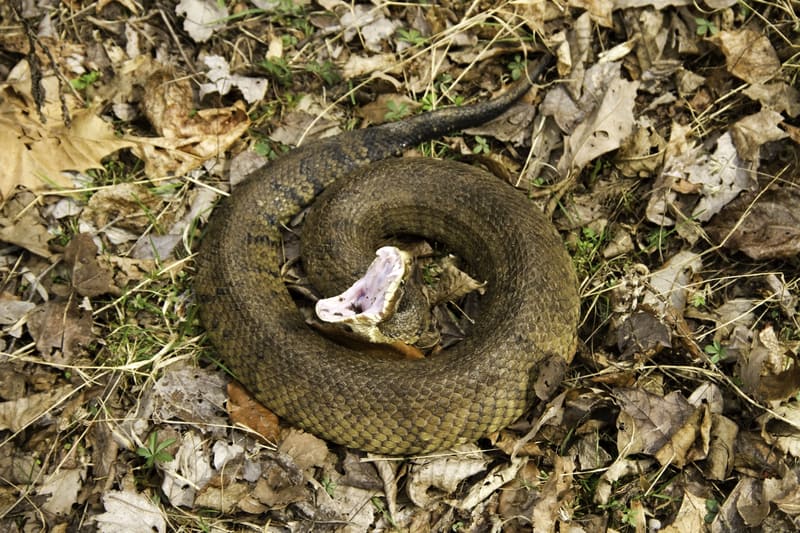
Northern Cottonmouth (Agkistrodon piscivorus)
Another common name for the Northern Cottonmouth snake is water moccasin. They look a little bit like rattlesnakes without the rattle on the tail. Sometimes, a cottonmouth is mistaken for a Northern Water Snake. This could be a dangerous mistake.
What Do Northern Cottonmouths Look Like?
| Size | *These snakes grow up to 3 feet (0.91 m) in length. |
| Coloration | *Adults: Dark brown to black body with minimal markings. *Inside of the mouth: White, giving them the name “cottonmouth.” *Juveniles: More defined patterns, resembling a copperhead with darker bands that widen toward the belly and narrow along the back. *Inside is pale pink to white, visible during their defensive open-mouthed pose (origin of the name “cottonmouth”). |
| Body Shape | *Stout, muscular snakes. |
| Behaviors | *Cottonmouths arc their heads upward and display an open-mouthed pose when agitated. This exposes the white interior of their mouth. This is a warning to back off or suffer the consequences. *Interestingly, they can hold their breath underwater for up to an hour while hunting for prey. |
| Distinctive Features | *Pupils are cat-like and elliptical, appearing as narrow slits during the day. At night, pupils appear round. |
| Conservation Status: | *Common within their range in South Carolina. |
Where Do Northern Cottonmouths Live in South Carolina?
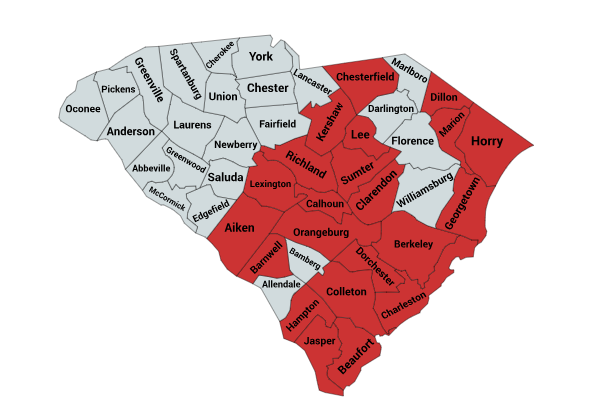
These snakes are found throughout the southeastern half of South Carolina.
They are semi-aquatic snakes. They favor wet habitats such as swamps, drainage ditches, slow-moving rivers, and lakes. They commonly sun themselves on rocks or logs at the water’s edge. Cottonmouths sometimes venture overland. It’s not unheard of to see one far from any aquatic environment.
What Do Northern Cottonmouths Eat?
These snakes prey on fish, freshwater crustaceans, amphibians, small mammals, and other reptiles. Cottonmouths sometimes congregate around drying wetland pools to feed on any trapped fish.
How Dangerous Are Northern Cottonmouths?
Cottonmouth snake venom is cytotoxic. This means it destroys body tissue. Northern Cottonmouth bites sometimes lead to the amputation of limbs. On rare occasions, death can occur.
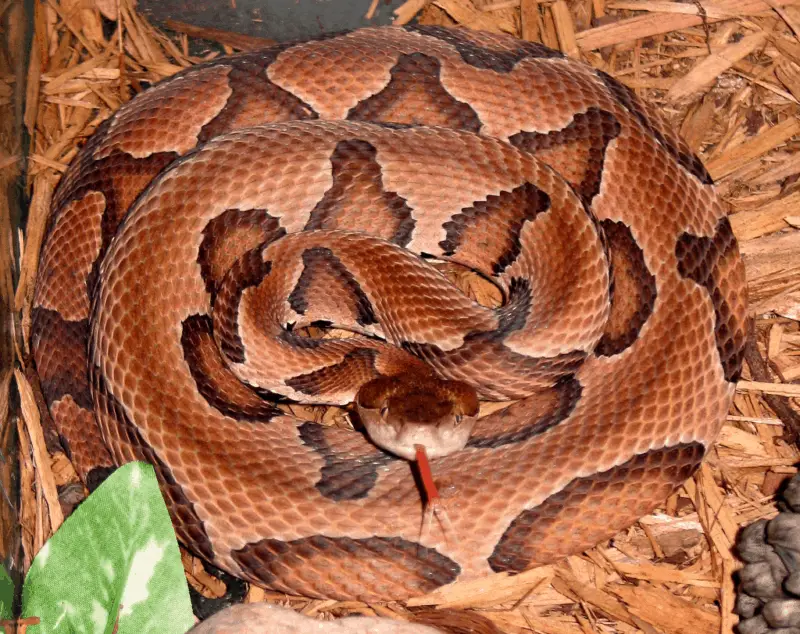
Eastern Copperhead (Agkistrodon contortrix)
The Eastern Copperhead is a pit viper native to the eastern United States.
What Do Eastern Copperheads Look Like?
| Size | *Adults range from 20 to 37 inches (50 to 95 cm) in length. |
| Coloration | *Reddish-tan to grayish-tan bodies. *Overlaid with dark brown, hourglass-shaped markings. *Heads are dark coppery brown, giving them the name “Copperhead.” |
| Body Shape | *Stout and heavy-bodied snakes. *As with all pitvipers, their heads are triangular and appear oversized in relation to their necks. |
| Conservation Status | *Common within their range in South Carolina. |
Taxonomy of South Carolina’s Eastern Copperhead Snakes
Copperhead snakes are found across South Carolina and are now recognized as a single species: the Eastern Copperhead (Agkistrodon contortrix).
In the past, copperheads were classified into different subspecies, including the Northern Copperhead, Southern Copperhead, and Osage Copperhead. However, recent DNA studies revealed minimal genetic differences between them. As a result, these subspecies were combined into a single taxonomic group under the Eastern Copperhead name.
Where Do Eastern Copperheads Live in South Carolina?
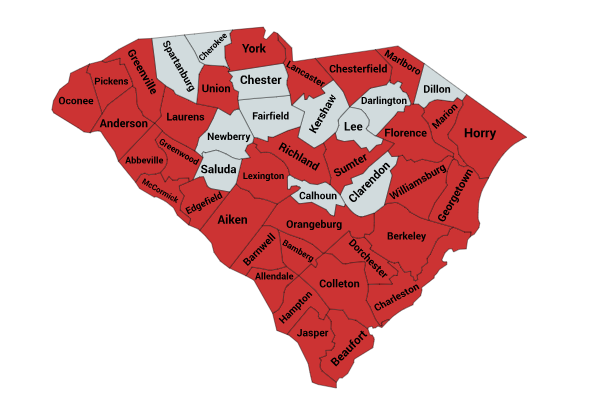
Eastern Copperheads are found throughout the state of South Carolina. They inhabit deciduous forests, evergreen forests, river bottoms, and rocky wooded hillsides.
Eastern Copperhead Behavior
Copperheads are dangerous because they use camouflage as their number one defense mechanism. In other words, these snakes choose to lie perfectly still rather than flee most of the time. Their camouflage helps them blend in with leaf litter and other ground debris.
When they feel threatened, they occasionally mimic the tail vibration of a rattlesnake. But, in most cases, they choose to lie perfectly still.
Most copperhead bites on humans occur when the person steps on or near the snake.
What Do Copperheads Eat?
Copperhead snakes are opportunistic feeders. They eat insects, spiders, frogs, small animals, birds, and other reptiles.
How Dangerous Are Copperheads?
A Copperhead can bite and inject venom from the time they are newly born. Like most pit vipers, they have hemotoxic venom.
Most copperhead bites are not life-threatening. On the other hand, any bite from this snake is a medical emergency and should be treated as such. Prompt medical attention increases the chance of a good outcome.
Copperhead bites can cause intense pain, shock, and swelling. Their bites also have the potential to cause blood in urine, tissue damage, and kidney failure.
An interesting study has found that Copperhead venom contains a protein called contortrostatin. Contortrostatin has been found to stop the growth of cancer cells in mice.
Rattlesnakes in South Carolina
What South Carolina’s rattlesnakes have in common with most other rattlesnake species is their rattle.
- Most rattlesnakes have a rattle at their tail’s end, comprised of hollow, loosely interlocked keratinous scales.
- Normally, a rattlesnake adds a new segment to its rattle each time it sheds its skin.
- An agitated rattlesnake rapidly vibrates its tail, causing the segments of its rattle to vibrate together, creating a buzzing or rattling sound.
- Not all rattlesnakes rattle before they strike. Sometimes, they lose their rattles due to injury, and sometimes, they choose not to rattle.
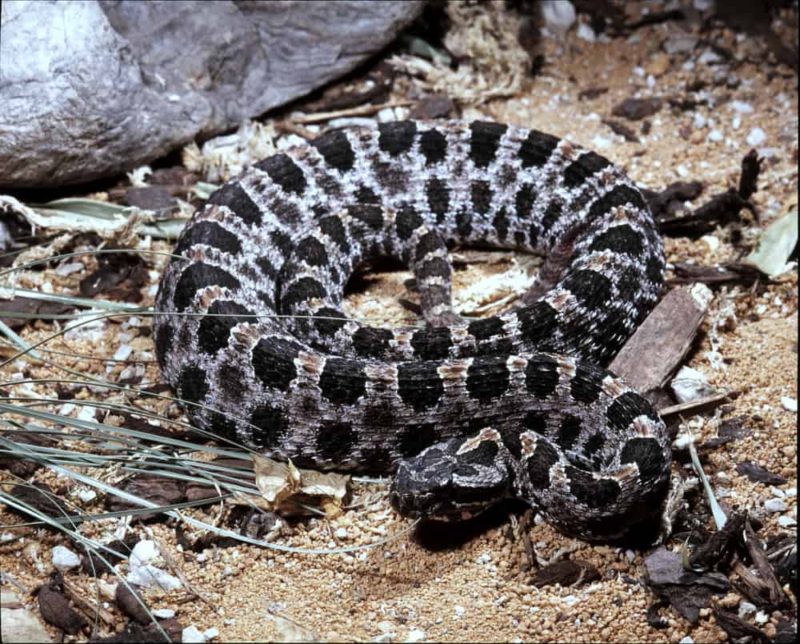
Dusky Pygmy Rattlesnake (Sistrurus miliarius barbouri)
These snakes also have other common names. A couple of them are Barbour’s Pygmy Rattlesnake and Pigmy Rattlesnake.
| Size | *Small, slender-tailed snake with a tiny rattle. *Length: 14 to 30 inches (36 to 76 cm). *Average length: 21.1 inches (54 cm). |
| Coloration and Markings | *Body: Dark gray with dark-colored blotches along the top and sides. *Stripe: Rust-colored vertical stripe on the back (may be absent in some individuals). *Belly: Cream-colored, often mottled. *Face: Distinct dark stripe from the corner of the mouth to the eye. |
| Rattle and Sound | *A tiny rattle produces a faint, grasshopper-like buzz. *Sound can only be heard from a few feet away. |
| Conservation Status | *Common within their range in South Carolina. |
Where Do Dusky Pygmy Rattlesnake Live in South Carolina?

Dusky Pygmy Rattlesnakes are located throughout much of South Carolina in the sandhills, mixed forests, and floodplains. They are also located near marshes and lakes.
How Dangerous Are Dusky Pygmy Rattlesnakes?
Dusky Pygmy rattlesnakes have cytotoxic venom. By definition, cytotoxic venom destroys the body’s cells. It contains digestive enzymes that disrupt blood flow and prevent blood from clotting. Luckily, these snakes produce a small venom yield. Dusky Pygmy Rattlesnake bites are painful. But there has never been a human fatality caused by one. However, any pygmy rattlesnake bite victim should still receive prompt medical attention.
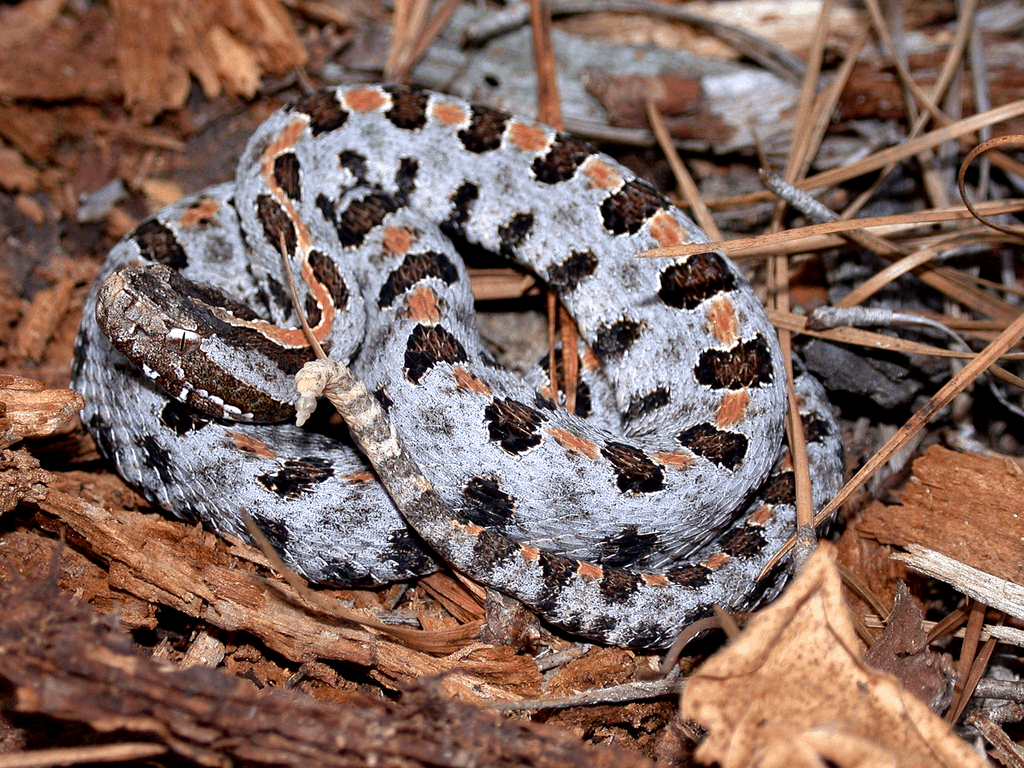
Carolina Pygmy Rattlesnake (Sistrurus miliarius miliarius)
This snake has some other common names. They are Pigmy Rattlesnake, Ground Rattlesnake, and Hog-nosed rattlesnake.
What Do Carolina Pygmy Rattlesnake Look Like?
| Size | *Small, slender-tailed snake with a tiny rattle. *Length: 16 to 25 inches (41 to 64 cm). *Average length: 21.1 inches (54 cm). |
| Coloration and Markings | *Body: Light gray to reddish above, with dark-colored blotches along the top and sides. *Stripe: Rust-colored vertical stripe on the back (may be absent in some individuals). *Belly: Cream-colored, often mottled. *Face: Distinct dark stripe from the corner of the mouth to the eye. |
| Rattle and Sound | *A tiny rattle produces a faint, grasshopper-like buzz. *Sound can only be heard from a few feet away. |
| Conservation Status | *Common within their range in South Carolina. |
Where Do Carolina Pygmy Rattlesnakes Live in South Carolina?

Carolina Pygmy Rattlesnakes are located throughout much of South Carolina.
They favor sandhills, mixed forests, floodplains, marshes, and borders of cypress ponds. These snakes are rarely found in extremely dry habitats.
How Dangerous Are Carolina Pygmy Rattlesnakes?
Carolina Pygmy rattlesnakes have cytotoxic venom. By definition, cytotoxic venom destroys the body’s cells. Luckily, these snakes produce a small venom yield. A Pygmy Rattlesnake bite is unlikely to be fatal. However, any bite victim should still receive prompt medical attention.
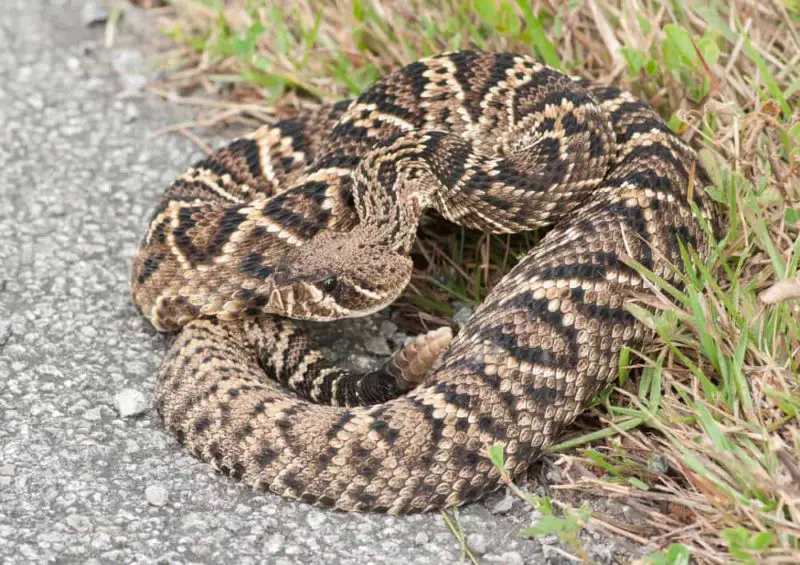
Eastern Diamondback Rattlesnake (Crotalus adamanteus)
The Eastern Diamondback Rattlesnake is the largest venomous snake in the United States.
The Eastern Diamondback Rattlesnake is indigenous to the southeastern United States. They are also referred to as the Eastern Diamond-Backed Rattlesnake. People also call it the Eastern Diamond Rattlesnake.
What Do Eastern Diamondback Rattlesnakes Look Like?

| Size | *Average length: 3 to 6 feet (0.91 to 1.83 m). *Record length: Up to 8 feet. *Average weight: 5 to 10 pounds (2.27 to 4.54 kg). |
| Coloration | *Base colors: Brownish-yellow, brownish-gray, or olive green. *Back: Brownish-black diamond-shaped pattern lined with cream-colored scales. *Tail: Diamond blotches transition into crossbands near the tail. *Belly: Cream-colored with dark mottling along the sides. |
| Distinctive Markings | *The black band is outlined with white bands on either side. *A black band runs from behind each eye down towards the mouth. |
| Conservation Status: | Species of Concern |
Where Do Eastern Diamondbacks Live in South Carolina?
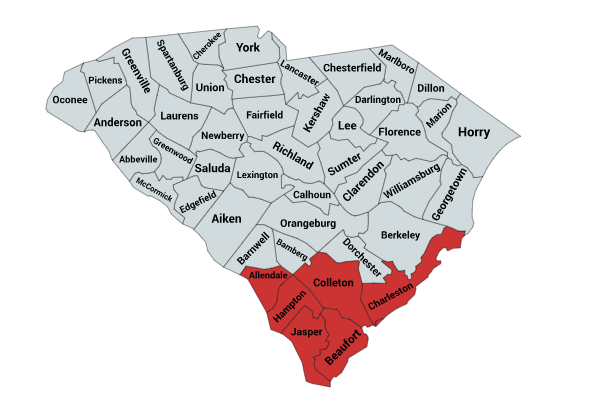
The Eastern Diamondback is found in the eastern to the southeastern part of the state.
They prefer coastal forests, scrublands, and pine and wiregrass flatwoods. They can be found in moist areas such as wet prairies, savannas, and around wetland borders. These snakes are proficient swimmers. It’s not uncommon for them to swim between barrier reefs and along swamp edges.
Eastern Diamondback Rattlesnake Behavior
Eastern Diamondbacks shelter in gopher, tortoise, and armadillo burrows. They emerge early in the morning or afternoon to bask in the sun. Occasionally, these snakes climb into bushes and trees, hunting for prey. Some have been spotted as high as 33 feet off the ground.
How Dangerous Are Eastern Diamondback Rattlesnakes?
Eastern Diamondback Rattlesnakes have powerful hemotoxic venom. They kill more people than any other venomous snake in the United States.
Eastern Diamondback bites cause severe pain, edema, headache, nausea, dizziness, and convulsions. Their hemotoxic venom impairs blood coagulation. This may lead to severe internal bleeding, which may lead to kidney damage.

Timber Rattlesnake (Crotalus horridus)
Timber Rattler and Canebrake Rattlesnake are both common names for the Timber Rattlesnake. Generally, in higher-elevation habitats, they are called Timber Rattlesnakes. On the coastal plain, though, they’re called Canebrake Rattlesnakes.
What Do Timber Rattlesnakes Look Like?
| Size | *Average length: 36 to 60 inches (0.91 to 1.52 m). *Rare cases reported: Up to 7 feet (2.13 m). |
| Coloration | *General base color: Yellowish-brown to grey-brown. *Chevron pattern: Dark brown to black chevrons on their back and sides against a lighter base color. *Back stripe: Rusty to reddish stripe running down their back. *Tail color: Dark brown or black. |
| Melanistic Variation | *Some timber rattlesnakes exhibit a dark, melanistic color morph. *These snakes can appear almost entirely black. *The tail is darker than the rest of the body in this morph. |
| Behaviors | *These snakes are excellent climbers. In fact, timber rattlers have been found in trees at heights of more than 80 feet. *The experts have proven that timber rattlesnakes help control Lyme disease. This is because as they consume rodents, they’re also consuming ticks. A timber rattler will consume 2,500 to 4,500 ticks per year, depending on the location. |
| Conservation Status: | Common within their range in South Carolina. |
Where Do Timber Rattlesnakes Live in South Carolina?
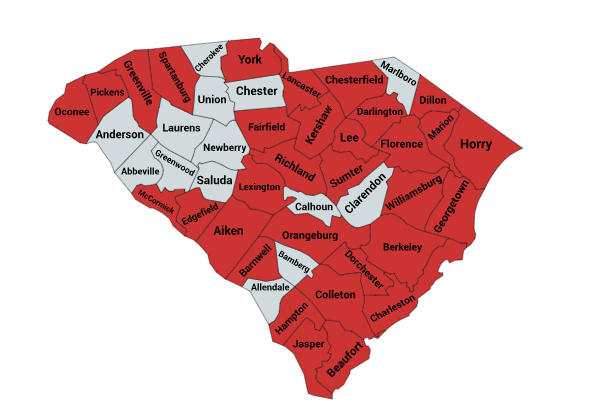
The Timber Rattlesnake lives in various habitats. These include deciduous forests, pine forests, swamps, farm fields, and river floodplains. These snakes are marvelous climbers and have been found in trees at heights of more than 80 feet.
What Do Timber Rattlesnakes Eat?
Timber rattlers prey on small mammals such as mice, rats, squirrels, and chipmunks. They also eat small birds, other reptiles, and amphibians.
How Dangerous Are Timber Rattlesnakes?
- Timber Rattlesnakes are among the most dangerous in the United States. This is due to their long fangs and high venom yield. 1% to 10% of untreated Timber Rattlesnake bites result in a fatality.
- Fortunately, 40% to 60% of the time, they produce dry bites. In other words, although their fangs penetrate the body, they do not inject any venom.
- These snakes produce hemotoxic venom. Timber Rattlesnake bites sometimes cause serious complications. These include shock, seizures, coma, internal bleeding, and deep tissue damage.
Wild Cats in South Carolina – Krebs Creek
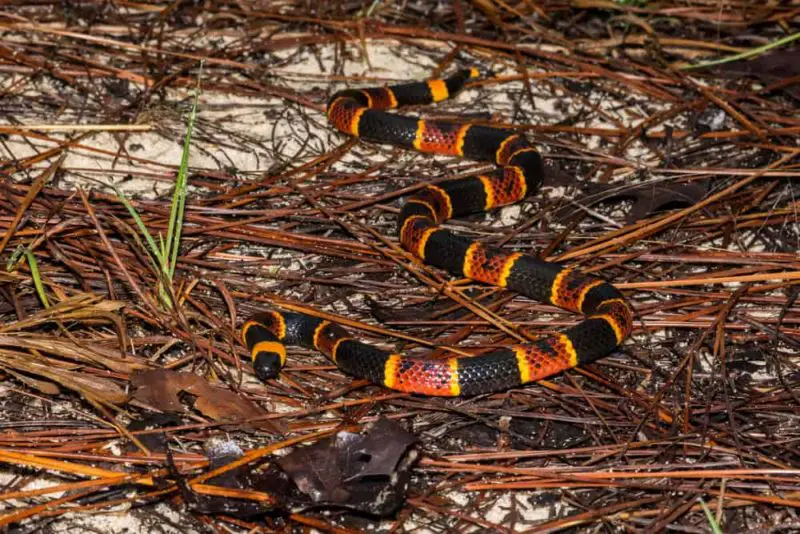
Eastern Coral Snake (Micrurus fulvius)
The Eastern Coral Snake or Harlequin Coral Snake is the only venomous snake in South Carolina that is not a pit viper. Instead, they belong to the Elapidae family, along with Cobras and Mambas.
What Do Eastern Coral Snakes Look Like?
| Size | Eastern Coral Snakes can grow up to 4 feet (122 cm), but most are around 2 feet (61 cm). Sexually dimorphic: Males are slightly smaller than females. |
| Physical Features | Rounded heads and noses, with tails that resemble the head. This similarity can make it hard to distinguish the head from the tail. |
| Coloration | Brightly colored, highly venomous snake. Bands of black, light yellow, and red. Yellow bands separate the red and black bands. |
| Conservation Status: | Common within their range in South Carolina. |
Where Do Eastern Coral Snakes Live in South Carolina?
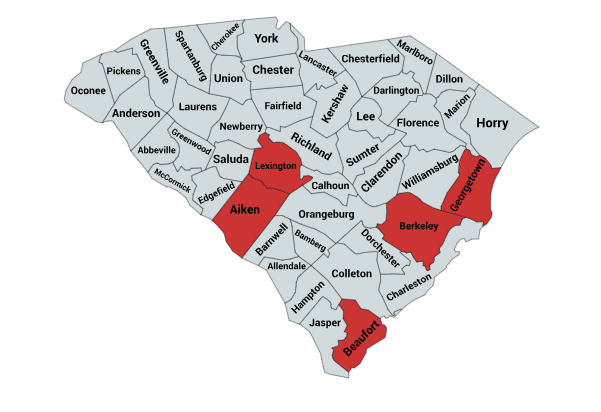
These snakes are found in the southeastern half of South Carolina. Look for them in the sandhills and along the coastal plains region. It is very rare to come across an Eastern Coral snake.
Batesian Mimicry Of Coral Snakes
Batesian mimicry is a biological term. It describes how a harmless species protects itself by resembling a dangerous one. For example, the scarlet kingsnake and the eastern milk snake are nonvenomous snakes. However, their color patterns closely resemble the venomous coral snake. The difference is that a coral snake’s red and yellow bands touch. On the other hand, the nonvenomous species’ color patterns are red, black, and yellow. Also, a coral snake’s head is blunt and entirely black, even behind its eyes, while a Kingsnake’s head is red.
This rhyme helps people distinguish between a nonvenomous species and a coral snake. “Red and yellow can kill a fellow; Red touches black, a friend of Jack.”
The rhyme is mostly accurate in the United States. However, coral snakes from areas south of the U. S. do not always follow the black-yellow-red pattern. This is also true in Central America, South America, and the Caribbean.
Finally, there are rare coral snakes that do not follow the usual color pattern in the United States. Pink, cream-colored, light blue, and completely black coral snakes exist in the wild.
What Do Eastern Coral Snakes Eat?
Eastern Coral Snakes primarily prey on other snakes. They also feed on small rodents, amphibians, and insects.
How Dangerous Are Coral Snakes?
Coral snakes have powerful venom with neurotoxic properties. Herpetologists regard them as the most venomous snake in the United States. Fortunately, they almost never bite.
Coral snake venom is a neurotoxin and is the second strongest of any snake. The experts consider coral snakes to be less dangerous than rattlesnakes, though. Their smaller mouths and short fangs produce less venom. Thus, they have a less effective venom delivery system.
People should take coral snake bites seriously, though. Before we had antivenom, the death rate after coral snake envenomation was around 10%.
A coral snake bite only causes mild swelling at the bite site. Furthermore, the effects of the venom may take up to 12 hours to set in. Some of the more serious effects of coral snake venom are listed below.
Potential effects of coral snake envenomation include:
- muscle weakness
- difficulty speaking
- difficulty swallowing
- difficulty breathing
- Inability to move eyelids
- blurred vision
- twitching of the tongue
- paralysis
- respiratory failure
One reported death has been caused by an Eastern Coral Snake bite in the last 40 years.
Avoiding Snake Bite
Copperheads are responsible for the most venomous snake bites in Tennessee. These snakes are pretty well camouflaged. They often remain perfectly still to avoid detection. If you’re walking in the woods and unknowingly get too close, a copperhead might not move, hoping you’ll pass by. Many snake bites happen when someone accidentally steps on the snake. To stay safe in snake habitats, always watch where you step and where you place your hands.
Another common cause of snake bite is attempts to capture or kill a snake. Remember, venomous snakes can strike instantly, delivering a potentially life-threatening bite. The safest approach is to keep a safe distance and leave them alone.
Dressing for Snake Country
- High-top leather boots and long pants are both wise ideas.
- Also, wear loose-fitting denim. If there’s a gap before the snake’s fangs touch your skin, your chances of being envenomated are lower.
- In the absence of high-top leather boots, some people wear snake gaiters.
Symptoms of Venomous Snake Bites
Some of the symptoms you may experience when a venomous snake bites you include:
- Discoloration in the area of the bite.
- Swelling in the area of the bite.
- Loss of muscle coordination.
- Tingling sensation in the area of the bite.
- Feeling nauseous.
- Having a faster heartbeat or rapid pulse.
What Should You Do if You Are Bitten?
If you or someone you are with has suffered a venomous snakebite, time is of the essence. Because the sooner a victim receives antivenom, the less chance the venom in their body has to cause harm. In other words, it is important to seek immediate medical treatment.
Do not attempt to kill the snake for identification purposes. This gives the snake a chance to bite you again. Also, consider that severed snakeheads can still bite and envenomate and often do. If you have a phone, take a picture of the offending reptile. Otherwise, get started on your way to the nearest hospital.
First Aid for Snake Bite Victims
- Remain calm and limit your movements. Do not run. If you must hike back to a vehicle, do it calmly and deliberately. Put as little stress on your heart as possible.
- Keep the area of the snake bite below the heart level and never above the heart level. Keeping the bite below the heart level will reduce the venom’s flow. However, holding the bite above your heart level will increase the venom’s flow.
- Remove all constricting items such as bracelets, watches, or rings before swelling occurs.
- Remember that using a cold compress on a venomous snake bite is not advisable. The cold may cause the local blood vessels to constrict and spread the venom faster.
- You can wash the affected area like any other wound with soap and water.
- You may cover the bite area with a moist dressing to reduce the swelling.
- Get medical attention as soon as possible. Call the hospital to tell them a venomous snake has bitten you so they can have antivenom ready to give you when you arrive.
- A person whom a venomous snake has bitten may go into shock. If this happens, lay them flat and cover them with a blanket.
Conclusion
South Carolina’s venomous snakes have deservingly menacing reputations. Despite this fact, they are interesting animals that play vital roles in the ecosystems that they exist in. Anyone venturing into South Carolina’s outdoors should learn to identify these snakes, understand their behaviors, and recognize their habitats. This way, you can minimize the risks of a potentially dangerous snake encounter.
When you’re in snake country, stay vigilant. Pay particularly close attention to where you place your feet and hands. If you encounter a venomous snake, give it plenty of space. Finally, any venomous snake bite victim should seek prompt medical attention. This will maximize the chance of a positive outcome.
Recent Posts
The only venomous snakes in Washington State are Northern Pacific Rattlesnakes. The Northern Pacific Rattlesnake (Crotalus oreganus oreganus) is a sub-species of the Western Rattlesnake. Anyone...
Skunks are not classified as true hibernators. But they go into a state of torpor when the weather gets cold. Skunks are light sleep hibernators, along with opossums, bears, and raccoons. ...

